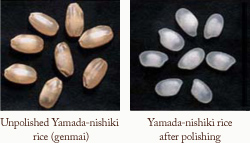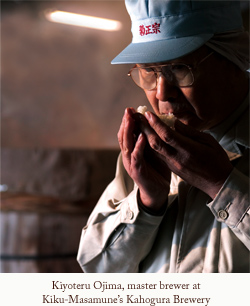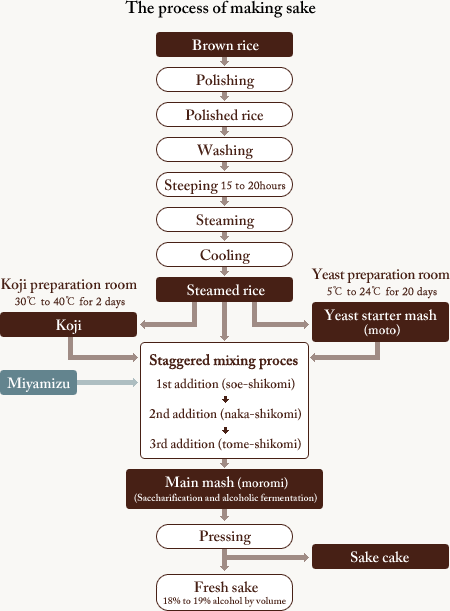![]()
The name "Masamune" is believed to have entered into use in the 1830s, when its alternate pronunciation of seishu mirrored another Japanese word meaning sake.

Japanese sake can be enjoyed in a variety of temperature ranges depending on season, mood, and characteristics such as flavor and aroma. It is recommended to enjoy junmai sake (one type of special-designation sake) at a slightly lower temperature of about 45℃ (nurukan), while honjozo sake (another special-designation sake) and futsu-shu (ordinary sake) should be consumed at the somewhat higher temperature of about 50℃ (jyokan). By contrast, ginjo sake (another special-designation sake) and namachozo-shu are typically consumed either cooled or at room temperature. That said, the choice of how to drink Japanese sake is a personal one, and it should be remembered that these recommendations are only guidelines.
![]()
The caloric content of Japanese sake is determined primarily by its alcohol content. Our Jyosen Honjozo sake (15% alcohol) has 101 calories per 100 ml. Since the sugars in sake typically contribute about 18% of the beverage's overall caloric content, the number of calories in a serving of sake do not differ substantially from other liquors and spirits.
![]()
The alcohol in sake will serve as a source of energy if absorbed by the body, but it will not become part of the body's makeup. Whether you gain weight or not depends not so much on the Japanese sake you drink, but rather on the caloric content of the food you enjoy with the sake (whether starch, fats, etc.).
![]()
Japanese sake is classified according to the ingredients and methods used in its production. For example, junmai sake and honjozo sake are ingredient-based classifications. The name ginjo sake reflects the rice polishing ratio and brewing technique, while nama sake denotes a particular production process. Kimoto signifies differences in the method used to cultivate yeast during the brewing process. Since the flavor and price of different sakes vary greatly with these classifications, it's a good idea to memorize them for reference when choosing a sake.
![]()
Sake rice differs from ordinary rice in having a larger grain size and a white, starchy component (called shinpaku) at its center. The Yamada-nishiki variety, grown in Hyogo Prefecture, is typical in its low protein content and soft consistency, which makes it easier for Aspergillus oryzae (koji-kin), a mold used in the production of sake, to penetrate the rice. Furthermore, this variety's thin surface layer of bran makes it easy to absorb and digest but hard to husk during the milling process.
Yeast is a microbe that converts sugars to alcohol. Kiku-Masamune has developed its own strain of yeast based on microbes that have lived in sake breweries for hundreds of years, and it uses that strain so as to maximize its exceptional properties. This strain, known as Kikumasa yeast, excels in its hearty leavening capability and is extremely well suited to producing the delicious, dry sakes that bear the Kiku-Masamune label.
The rice polishing ratio indicates the amount of polished rice that remains after the outer layers of the rice are milled away. For example, a rice polishing ratio of 60% means that 40% of each grain has been removed as bran. Generally speaking, the rice's aroma is considered to increase as more bran is removed (i.e., as the rice polishing ratio decreases), leading to a taste with fewer impurities.

![]()
These indications, found on sake labels, describe the taste of the sake. Nishonshu-do is a numerical indicator of the degree of sweetness or dryness. Sake with the same specific gravity as water has a value of 0, sake with a higher specific gravity a negative value, and sake with a lower specific gravity a positive value. In short, the sugars that causes sweetness increase the specific gravity so that the sake has a negative value, while the absence of sugar in sakes with a positive value (and therefore a lower specific gravity) tends to create a clean, dry taste.
San-do indicates the acidity of the sake and is used as a gauge of intensity of taste. Typical values range from about 1.0 to 1.8, with higher values resulting in a strongly acidic flavor. Generally speaking, san-do values greater than 1.5 indicate a fuller taste, while values less than 1.5 indicate a light, smooth flavor.
Aminosan-do indicates the amount of amino acids in the sake, which affect its savoriness (goku-mi). Aminosan-do provides a simple measure of amino acid content. High amino acid content typically results in an increase in impurities, while low amino acid content indicates a clean, light-tasting sake. Most futsu-shu (ordinary sake) has an aminosan-do value of around 2.0.
![]()
The master brewer is responsible for managing the brewery's seasonal workforce, who produce sake during the winter only. The job demands brewing skill and a sense of intuition derived from long years of experience, as well as an ability to lead a large number of seasonal workers effectively so that delicious sake can be produced. Kiku-Masamune has seasonal breweries that only operate in the winter, and those facilities have master brewers. Those individuals are all Tanba master brewers (reflecting their roots in Hyogo Prefecture), but other master brewers—for example, those practicing the Echigo (Niigata Prefecture) and Nanbu (Iwate Prefecture) traditions—are also well known. The local character of each sake is reflected in characteristics such as its aroma and type.

![]()
Japanese sake, also known as seishu in Japanese, is defined by the Liquor Tax Act as "a fermented beverage made from rice, malted rice (kome-koji), and water." To answer a little more specifically, rice and water are combined, and some of the starch in the rice is converted into sugar by the koji to produce glucose, which is in turn fermented by the sake yeast to produce alcohol. These two processes—conversion into sugar and fermentation into alcohol—proceed in a balanced manner inside a single tank. Japanese sake, then, is the beverage obtained by means of this brewing process, which produces a high concentration of alcohol that is unique in the world.
![]()
The mold Aspergillus oryzae (koji-kin) converts starch into glucose, while yeast fungus converts the glucose into alcohol. Sake differs from other fermented alcoholic beverages such as wine and beer in that the glucose conversion and alcoholic fermentation occur simultaneously, a process known as multiple parallel fermentation.

![]()
The barreling process imparts aromas that complement the refreshingly dry taste of this type of sake, creating a rich and full-flavored beverage. Sweet sake already has a heavy taste, and the aromas added by the barrels only increase that tendency.
![]()
Once a bottle of sake has been opened, the processes of aging and discoloration accelerate due to exposure to air. Therefore, it is best to transfer the sake to a small container so that the area of the surface in contact with air is minimized and to keep the new container in the refrigerator, which helps preserve the sake's taste. It is best to consume the sake as soon as possible after opening it.
![]()
Consumed in moderate amounts, sake is believed to (1) stimulate the appetite, (2) soothe the mood and relieve stress, (3) promote cheerfulness, and (4) facilitate a good night's sleep as a nightcap. It also gives the skin luster, promotes beauty and prevents aging, and helps combat colds when used to make tamago-zake, a mixture of sake, eggs, and sugar. Based on these and similar health benefits, an old Japanese proverb describes sake as the best medicine.
![]()
Japanese sake is said to be beneficial for beauty because drinking it gives the skin a lustrous appearance. Conventional wisdom holds this to be the result of sake's ability to stimulate regeneration of new cells by improving circulation and of the vitamins, minerals, and other nutrients it contains. Furthermore, sake's ability to reduce stress and improve mental health helps maintain the body in a healthy state, which also has a beneficial effect on beauty. Finally, a small amount of Japanese sake added to hot or cold water used to wash your face has the effect of increasing the skin's luster in the manner of eau de toilette.